Here's the text.
Articles for FY2017
Last update date April 1, 2024
January 29
Visit to Svalbard Rock Ptarmigan
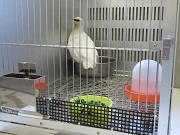
On January 21, a male Svalbard Rock Ptarmigan came from Toyama City Family Park.
Preservation and Research Center is currently conducting breeding tests and research using Svalbard Rock Ptarmigan, a closely related species, in cooperation with other zoos in Japan, in cooperation with the Ministry of the Environment's conservation plan for two Japanese groves. The number of Svalbard Rock Ptarmigan breeding conservation will be eight males and four females at this visit to the male garden, and we will be able to create new pairs without kinship.
January 5
I would like to announce the frog situation in Yokohama and the conservation
We will present the conservation of frogs that Preservation and Research Center is working on at the "Yokohama Animal Research Presentation" to be held on Saturday, February 3 at Nogeyama Zoo.
It is a great opportunity to learn about the habitat of frogs and conservation in the city.
Application for participation has been closed.
December 11
I gave a lecture at the Zoo to Wild Seminar at Kanazawa Zoo.
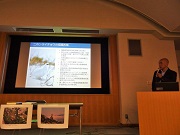
The Zoo to Wild Seminar "Japanese Rock Ptarmigan - Present and Future -" was held at Kanazawa Zoo on December 2. In Preservation and Research Center, as part of the Ex situ conservation project undertaken by the Ministry of the Environment and the Japanese Association of Zoos and Aquariums, we are aiming to establish breeding and breeding techniques using Svalbard Rock PtarmiganEx situ conservation.
On the day, there were about 30 participants. Hiroshi Nakamura, Professor Emeritus of Shinshu University, who is engaged in research on grouse and conservation activities, spoke about the current situation in the wild. After lunch break, Preservation and Research Center introduced the zoo's activities in conservation. After that, we toured the grouse breeding facility at Kanazawa Zoo and it was a long seminar that lasted 5 hours, but everyone who participated was eager to listen to the end.
I hope that this seminar will deepen our understanding of the ecology and current situation of the grouse, and increase the number of people who are interested in protecting it.
August 17
Takeko from Malayan Tapir moved to Yokohama Zoo
On July 18, 2017, Takeko (female) moved. Takeko, who came from Surabaya Zoo in Indonesia at the age of one year, is 19 years old this year. I've paired with some males so far, but unfortunately I didn't get pregnant. Therefore, it was this move to pair with the kaim (male) of Yokohama Zoo.
Takeko has a calm personality, loves brushing, lying himself, and sometimes sleeping for a while after brushing.
Even though it is on the same premises, it will move from Preservation and Research Center to the Yokohama Zoo's Tapir's breeding facility in a transport box. In order to get used to the transportation box, a box was set up at a breeding ground in Takeko about three weeks before the movement. I didn't feel scared, but I always checked it every day. On the day of the trip, I was relieved to enter the transportation box safely. I hope that pairing with kaim will work well at Yokohama Zoo.
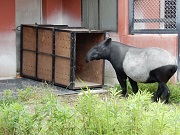 Takeko who strictly checks the transport box
Takeko who strictly checks the transport box
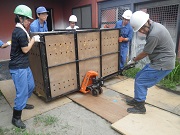 Carefully move the transport box containing Takeko
Carefully move the transport box containing Takeko
July 28
Japanese Night Heron's chicks nested
In early June, three Japanese Night Heron hatched from their eggs. It is the third consecutive year of breeding after the first breeding in Japan two years ago. The male and female identified these chicks and found that one of the three of them was female and two were male. All three Japanese Night Herons that grew up in the past two years were male, so I hoped they would grow up safely, but on July 12, they began to nest.
We hope that the breeding of females will further promote the breeding of Japanese Night Heron in the future.
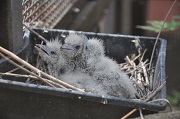 7-day-old chick
7-day-old chick
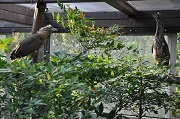 Nested chicks
Nested chicks
July 14
The chicks of Walldrapp Ibis were born
Preservation and Research Center now has two Walldrapp Ibis chicks. Walldrapp Ibis stays in the nest for about 45 days after birth and grows with food from the parent bird. The two birds hatched on May 24 and 26, so we hope that they will nest well in mid-July.
Walldrapp Ibis is only about 600 birds survive in limited areas such as Morocco and Turkey in the wild, and is a rare species designated by the Critically Endangered (CR) in the Red List of the IUCN. For this reason, zoos around the world are working on conservation, and in Japan, Preservation and Research Center is also contributing to these activities while managing the lineage of domestic breeding populations. Please watch the growth of Walldrapp Ibis chicks warmly!
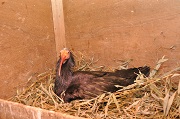 Parent bird in an incubation
Parent bird in an incubation
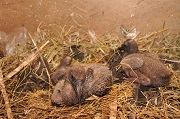 The chick on June 11
The chick on June 11
June 26
Ataru of Malayan Tapir joins from Tama Zoological Park!
On June 14, 2017, a male from Malayan Tapir (nicknamed Ataru) came from Tama Zoological Park. Ataru is a 3-year-old individual born in 2014. It weighs 356kg and has a solid body, but it seems that the face and gesture still have a childishness. I hope that they will become accustomed to living in Preservation and Research Center and become involved in breeding in the future.
※Ataru died on April 4, 2018.
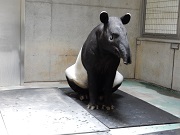 Ataru relaxes in the bedroom
Ataru relaxes in the bedroom
 Arrived in a special box
Arrived in a special box
Inquiries to this page
Yokohama Green Environment Bureau Park Green Space Division Zoo Division Preservation and Research Center
Telephone: 045-955-1911
Telephone: 045-955-1911
Fax: 045-955-1060
Email address: mk-hansyoku@city.yokohama.lg.jp
Page ID: 735-521-441







